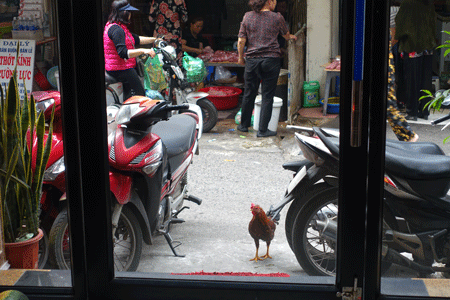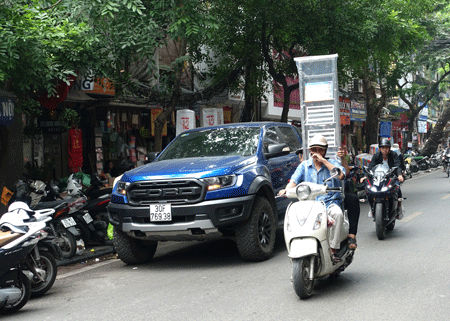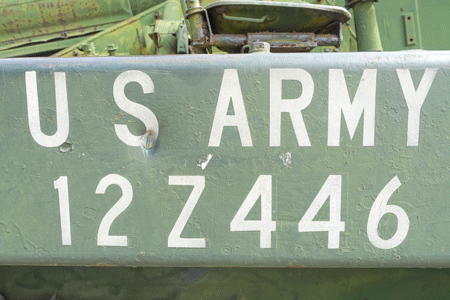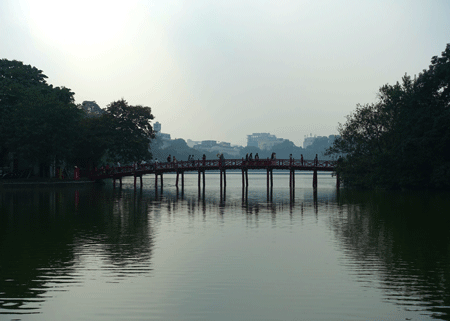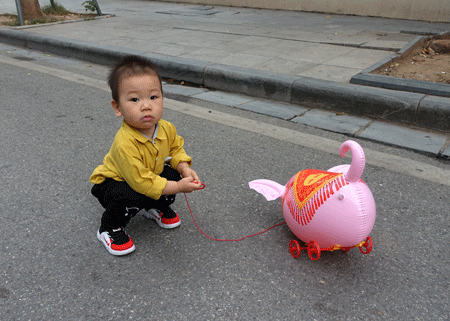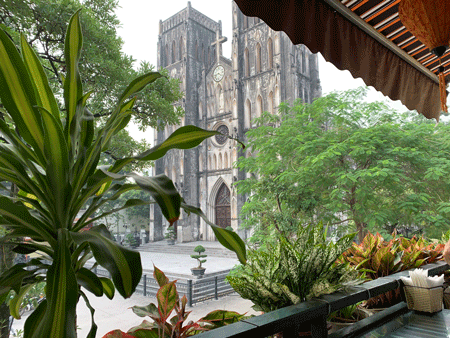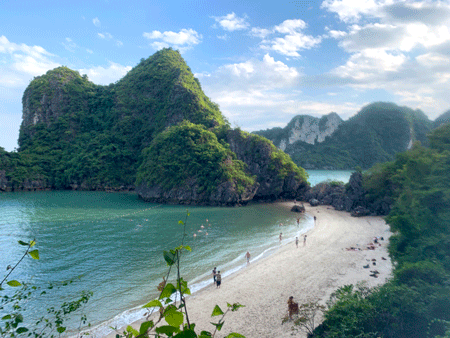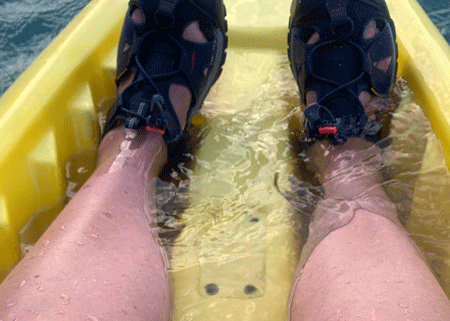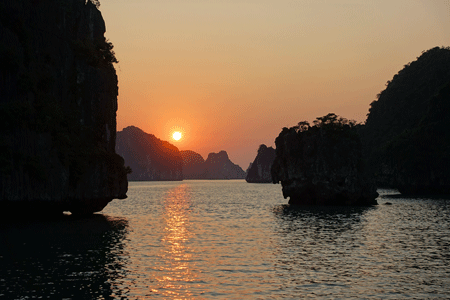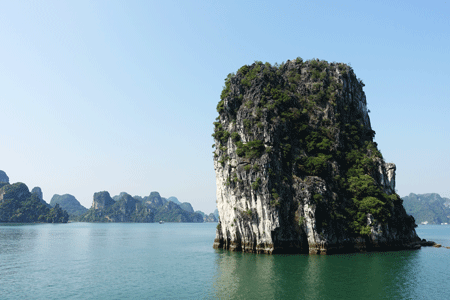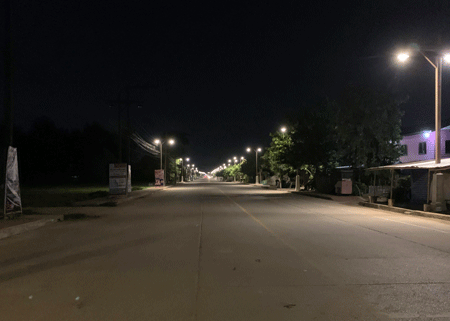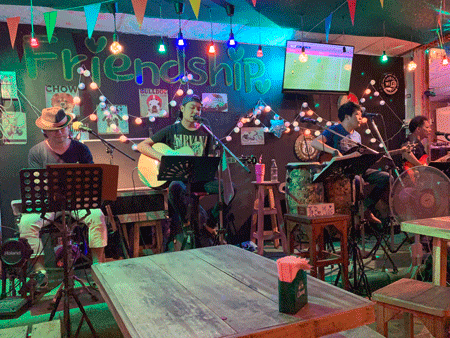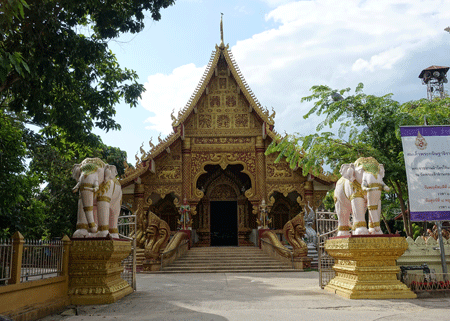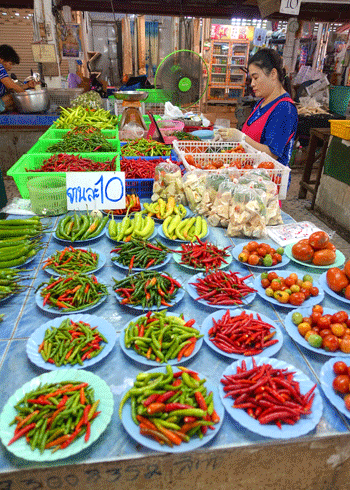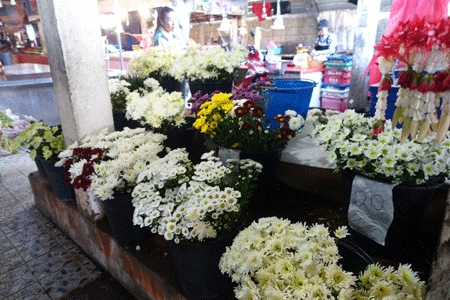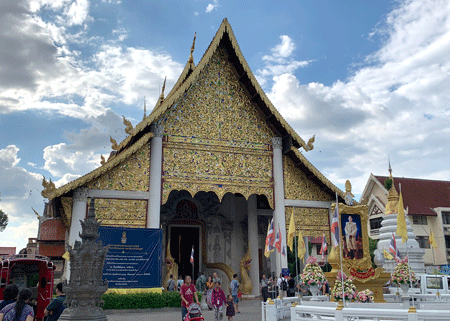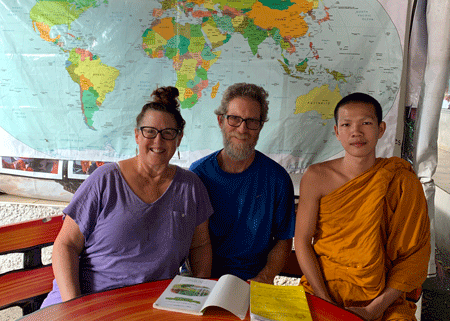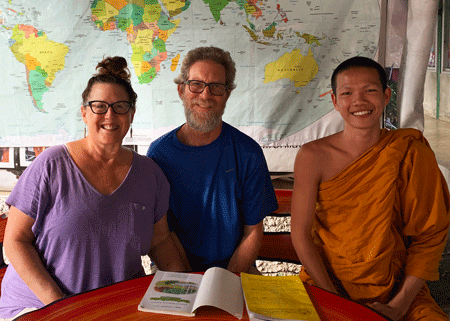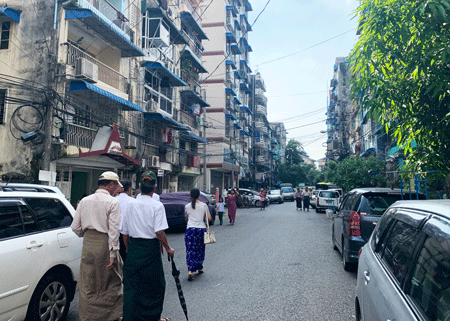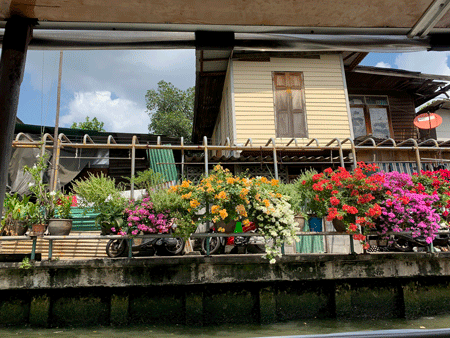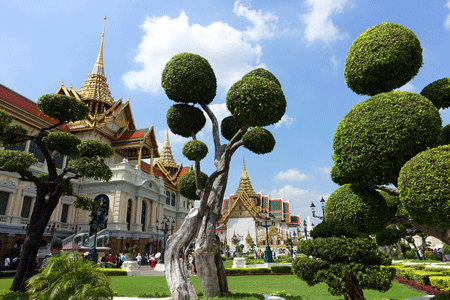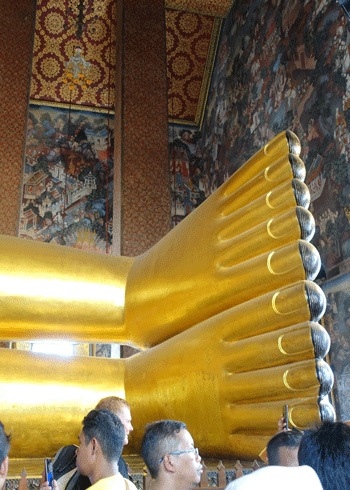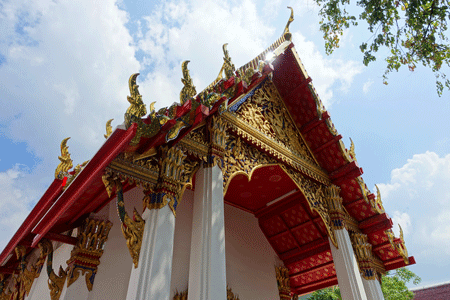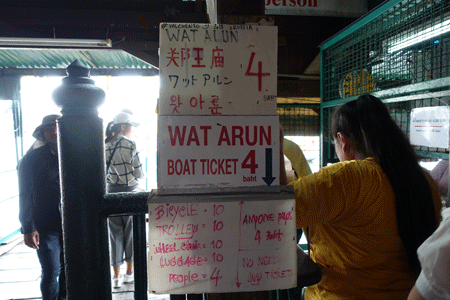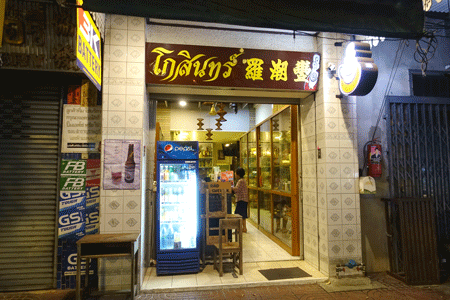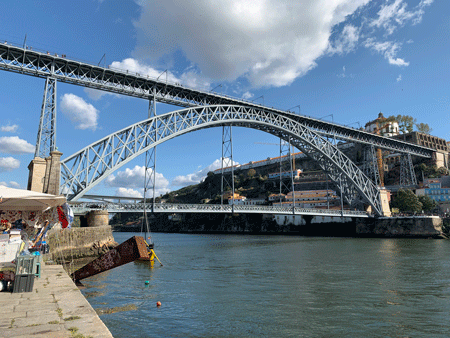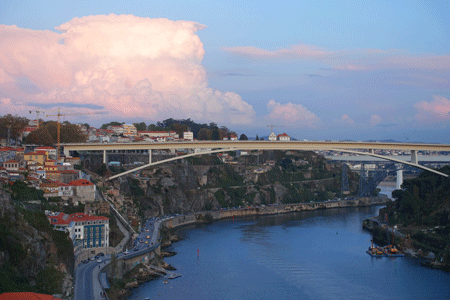Posted December 11, 2019

The Overnight Train
We boarded the overnight train heading to Sapa, Northern Vietnam, at 9:35 pm at the Hanoi train station. Our tickets read, “Pumpkin car, berths 16 and 18”.

Our sleeper cabin had four beds, two upper bunks, and two lower bunks. The blankets and pillow cases were embroidered with orange pumpkins (since we were in the Pumpkin car). The beds were split by a narrow “corridor” about 1.5 feet wide, which makes any kind of maneuvering, with four people and all their luggage, quite difficult.
With such tight quarters, you hope and pray that you get roommates that, #1) speak at least some English, #2) do not snore or make unseemly noises while sleeping, and #3) are not thieves or unsavory types. And it doesn’t hurt if they are friendly and don’t like to stay up too late.
Pierre & Starts with an “N”
Lucky for us our roomies were a nice, twenty-something couple from Paris. We started chatting and introduced ourselves. The man had an easy, quintessentially French and easy to remember name – Pierre. The woman, on the other hand, had a name that sounded very french and unintelligible (to me), that started with an “N”. I asked her to repeat it, and shook my head in thanks, but still had no idea how to pronounce or remember it, let alone use it later.
No worries, there were so few of us packed into such a tight space that it was easy to get her attention, if needed, even without using her name.
Arriving in Lao Cai
My night had been filled with rocking and swaying, train whistles blowing, really strange dreams that I was on a train (whaaaat?), and occasional blinding lights peaking through the swaying curtains. The train was due in to Lao Cai at 5:30 am.

Lao Cai is a town of about 98,000 people on the Chinese border, in the far north of Vietnam. The town was completely destroyed in 1979 when the Chinese invaded, and has since been rebuilt. It’s thriving now, mostly due to trade with China.
Coffee Anyone?
I set my alarm for 5:10 am. A woman that worked on the train came down the corridor, banging on everyone’s compartment door, yelling something in Vietnamese that I can only surmise was “Get the hell up!”.

A minute later she came down the aisle again, asking for coffee orders. I wasn’t really awake enough, or organized enough, to add holding a cup of coffee to my morning challenges. I still had to pack up, get my shoes on, and try to fix my bed hair. Stepping off the train into the early morning darkness, the frigid air was a quick slap in the face. Turns out there was no need for that coffee after all. I was now quite wide awake, thank you very much.
Lao Cai was around 50 degrees, which seemed very cold after all our hot weather travels. Little did I know that Sapa, which was still 20 miles away and at a much higher elevation, would be even colder.
Sapa is Cold

Cold is one thing, but cold with high humidity is quite another. The day we arrived Sapa had both in spades. Sapa sits at 5400 feet elevation. It’s like the top of Stevens Pass ski resort back home in Washington State.
Unfortunately for me, I lost my down, packable coat on a plane about a month ago. My only protection from the cold was a long sleeve shirt with a thin, t-shirt weight hoodie, along with my only pair of pants and wool socks with Keen sandals.

After checking into our hotel room (that had a stunning, sweeping view of the mountains) we walked around town. It was in the low 40’s with 89% humidity and an icy breeze. I was freezing, freezing, freezing.
Sapa is fairly small and walkable, albeit quite hilly. It has a population of about 9,000. You can walk from one end to the other in 20-25 minutes.
Hmong & Red Dao
Walking around Sapa, one of the first things you notice is the ethnic women from the surrounding hill villages, mainly the Hmong and Red Dao, working the streets to sell their handicrafts.

Hmong woman 
Hmong woman
The Hmong wear brightly colored plaid scarves on their heads for warmth.

Scarf style Red Dao hat 
Red Dao Hats
The Red Dao wear a red hat or scarf , depending on what village they are from. The red scarf resembles a traditional western Santa hat, which seemed appropriate for this time of year. Ho ho.
The Hard Sell

waiting for us to finish our coffee
I’d read about how aggressive the village women are when trying to make a sale, but I was still unprepared for the lengths they would go to. Firstly, they target tourists who are innocently in their hotel or eating in a restaurant. An outdoor table is the worst because you’re easy to spot and track.
You can see them waiting. They make eye contact and smile a knowing smile. They know you cannot get away. As soon as you come out onto the street, they latch on to you and won’t let go. They try to make friends with you, then try to reel you in.
Having some experience with this in Morocco, Mexico and Thailand, I knew what to do, and I immediately said a firm and polite “No thank you”. I don’t give them my name, or answer where I’m from, or answer any other of their questions. And I definitely don’t make eye contact.
No Thanks
Even though I’d say “No Thanks”, repeatedly, without wavering, they would follow me for a full block or two or three through the streets of Sapa.
“Maybe later?” they ask. “No”, I’d say. “Maybe tomorrow?” they’d ask. “No”, I’d say. “You bought from her, you buy from me” they’d say, even though I hadn’t bought from anyone prior. Eventually I’d break free of the selling machine disguised as a Hmong villager. Done with me, the saleswoman would immediately transfer over and latch on to Steve, her next target. It didn’t matter that I was standing a few inches in front of Steve, he was fresh meat.


I kept up my pace, forging ahead, but was carefully listening to the conversation behind me. In desperation I heard Steve reply “Ok” to the “Maybe tomorrow?” plea. But I knew we were in trouble when he also said “Ok” to her next question, “You promise?”
The very next day that same woman recognized us and came over pleading and begging and reminding Steve of his “promise”.
We didn’t cave-in, but it took vigilance and a lot of resolve. Those ladies are tough. By our fourth day in town it became like a game for me and some of the ladies and I would recognize each other and smile or laugh.
Finally on day four, I will admit, I broke down and bought a batik scarf from one of my Hmong friends, so I guess all her work wasn’t for nothing after all.
Lunch and the Big Freeze
We stopped for lunch at an open air restaurant. Before taking a seat, we picked out our selections from the huge variety of skewers on the street-side table. The table was full of skewers packed with meats and vegetables of all kinds, some of which we even recognized. Our choices were immediately placed on the adjacent, red hot grill, then brought to our table when crispy and cooked through.
“North Face” to the Rescue
This restaurant, like many in Vietnam, had a large sliding garage type door as its storefront. This open-air set up is optimal in the heat and humidity found in most of Vietnam, but in Sapa, in December, it was less than ideal. As we sat and ate, the cold damp air seeped into my bones. It was more than enough to convince me that drastic measures were called for. Right after lunch we made a bee-line to one of a dozen of shops in town that featured fake North Face products.
I was determined to get warm. After heavy negotiations, I walked out of the store with a navy blue down “North Face” coat and hot pink “North Face” mittens. Total bill, about $17. Not bad. The coat’s zipper is a bit shoddy, and the velcro is flimsy, but it will serve its purpose well, and I only need it to work for four days.
Further Notes on the Cold
As I’ve already mentioned, Sapa is high in the mountains, so it’s not surprising that it’s cold. What is surprising is that nothing in town is heated except the individual hotel rooms. And I mean nothing. The hotel lobby, the hotel buffet breakfast room, the restaurants (even ones with four walls and a closing door), and the shops – all have no heat. A few restaurants have a free-standing bbq pit in among the tables, which would be quite concerning if the rooms were not so drafty (not air tight).
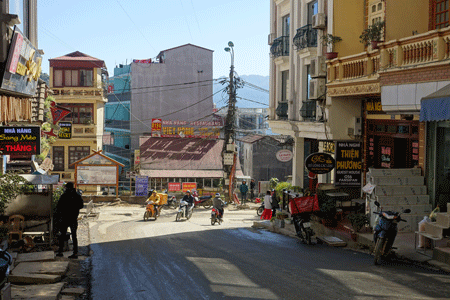
So every time we’d leave our hotel room, even to go downstairs for our morning breakfast buffet, we have to bundle up like we’re heading out on an arctic expedition.
Eating dinner, fully bundled up in a down coat, neck scarf, warm hat, and mittens while sitting inside a restaurant is commonplace. It’s like camping all the time. It sure does make the warm hotel room a welcome haven.
I’m Ready
Now that I had the essentials to keep warm, I was set for our trek in the mountains. Unlike me, Steve had kept tabs on his jacket. He planned on adding an additional layer, wearing my brightly colored ethnic-style Elephant shirt (with fringe all along the bottom) from our Thai excursion.
Sapa Sisters

We had pre-booked a two day trek to hike to three tiny, ethnic villages in the mountainous region of Vietnam through Sapa Sisters. We’d be staying overnight at a beautiful guesthouse high on a mountainside, “Zao’s House”.
We’d heard about Sapa Sisters from fellow Halong Bay boat-mates, two friends who had recently graduated with their doctorates from Stanford. They raved about the trekking company.
Female Owned & Operated
Sapa Sisters are Hmong trekking guides from Mung Hoa Valley, near the town of Sapa. They are the only female and Hmong owned trekking company in Sapa and are proud to operate a business that ensures all of their guides a fair salary and opportunities to grow in the community. They’ve been able to create a business that supports themselves and their families, and ensures long term employment and security.
We were thrilled to support such a progressive company empowering women here in northern Vietnam.
Our Guide, Ru

We met Ru, our trekking guide, the next morning at 8:45 am at the Sapa Sisters office, about a two minute walk from our hotel. Ru was very petite, as most Hmong are. She had long, dark, straight hair, tied back into a pony tail, and wore the traditional brightly colored plaid scarf tied on her head, as seen on Hmong women all over town.

Ru has an outgoing personality and exudes a solid confidence in her abilities as a trekking guide, having lived in the mountains near Sapa her entire life. She’s 22 years old, was married at age 17 (on the older side for women in her village, where most girls marry by age 15), and has three daughters, ages 5, 3, and 1.5. Her husband is a farmer and stays home to take care of “the babies” while Ru works as a guide three to four days a week.
Learning about Ru’s life growing up in a Hmong village, about an hour away from Sapa by motorbike, helped make our trek even more special and memorable.
The Ethnic Minorities Museum

We’d gone to Sapa Culture Museum the day before our trek to learn about the ethnic minorities that live in villages around Sapa.
It was shocking to learn that Hmong men, still to this day, have the option of kidnapping their prospective bride, often during Tet (New Years) celebrations. The man gathers a few friends and they ambush the woman, taking her by force and detaining her for three days. The museum’s information said that during the three days the woman is wined and dined (so to speak), with the intention of convincing her to agree to the marriage at the end of her captivity.
Kidnapped
I was hoping that the word “kidnapping” was a bad translation, and it wasn’t as bad as it sounded. I hoped it was actually a cultural practice where the girl was “in on it” and it was all in good fun.
But when talking to Ru about bride kidnappings, she said the kidnapped woman has no choice and must agree to marry her kidnapper at the end of the three days. She said all girls live in great fear during Tet, when most kidnappings occur.

I can’t imagine living in a patriarchal culture where being kidnapped and forced to marry is an accepted practice. It’s horrific to come face to face with someone who has lived a life under these circumstances, and experienced this fear first hand.
Thankfully Ru’s story was different. Not all men kidnap. Many parents of boys will decide who is a good marriage match, with or without input from their son, and solicit a meeting with a girls parents to ask for their consent. Ru knew and liked the boy who she married, whose parents made arrangements with her parents. She had the prerogative to say yes or no. Ru is happy in her marriage. She’s one of the lucky ones.
The Trek
Besides marrying by choice, Ru is fortunate to have a husband that supports her working as a guide. She’s a great guide, and we were lucky to have her.

Trekking sounds so athletic and impressive (to me). I’d like to say we trekked for six or eight hours each day, through rough terrain, but we didn’t. In actuality, we did a modified-trek, due to my bad knees. Our trek was private, with just Ru, Steve, and I, so we could customize it to best meet our needs. We chose a combo of trekking and car-assist. We trekked about 3 hours each day, on mostly flat trails and dirt roads.

Day one we had to cross a river. The bridge was out, so we had to make due. We crossed the river by climbing over large and slippery rocks, then carefully walked side-step on unsecured long metal planks with raised edges. The planks weren’t stable and shifted under our feet. It was difficult.
Thankfully two Hmong women had latched on to us (for our entire day one trek), because without their help I don’t think I would have made it safely over the river. They earned the tip we gave them at the end of the day.
We then trekked through the village of Lao Chai and on to Ta Van, then hoofed it up an incredibly steep path for another 20 minutes to reach our homestay, Zao’s house.
Zao’s House

Zao is one of Sapa Sisters founders, who now lives in a house owned by the company with her husband and three kids, hosting homestays for Sapa Sister trekkers almost every night.
The night we spent at Zao’s House there were 21 trekkers that arrived throughout the afternoon. We all had dinner together and we made some fast friends – Vicki and Joe from Vancouver, Canada (but Joe is originally from the UK), Eunice from Los Angeles (but currently living in NYC), Lanie from Austria, and a family of four from Switzerland that are traveling for a year (who we may meet up with in Hoi An over Xmas).

The second morning I woke early and caught a glorious sunrise. After a yummy communal breakfast we headed out for trekking, day #2. We trekked back down to the village of Ta Van, then on to Giang Tachai, before getting a ride back to Sapa.
Trekking Views
On both days we passed by many buffalo, small village schools, local handicraft stores, locals homes, zillions of beautifully kept family vegetable gardens, and terraced rice fields that were recently harvested.
The scenery was simply spectacular. Breathtaking. Pictures just can’t do it justice.

The Kids
Our last day in town we spent the day in the sunshine in Sapa’s main square. It was the first day that we didn’t have to bundle up, and it was lovely.


It was a Saturday, so there was lots of traffic and people in town. Sapa is a popular weekend destination for the Vietnamese.
There were lots of children “on display” for tourists (I presume), all dressed up in their ethnic traditional finest clothes.
Many people were paying to take posed pictures with the kids, but I preferred to catch the candid shots, when they weren’t posing with forced smiles, and able to just be themselves.
Wins & Losses
Wins
- Chatting with a Red Dao (ethnic minority) woman on a park bench. Learning about her children and grandchildren, and her weekly seven hour walk into Sapa to sell her wares.
- Having the good fortune (and good timing) to catch a bride & groom getting their professional wedding photos taken in traditional ethnic Red Dao wedding clothes, and sneaking some pictures!
- Getting two out of three sunny days while in Sapa in December!

The happy couple 
Bride from the back
Losses
- Flailing and spinning around trying to avoid an enormous bee (the size of a hummingbird) that was determined to land on my face on trekking day #2, ultimately falling on my bum in a muddy ditch – but at least I came out of it unscathed!













